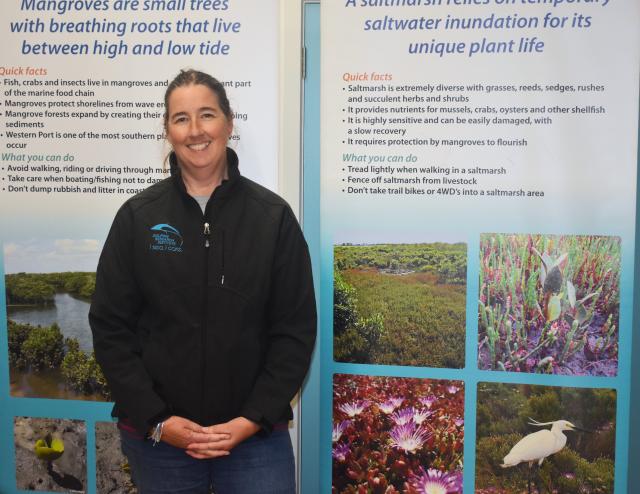While many Warneet locals aren’t happy about the location of the local mangroves, the City of Casey Sustainability Team stresses their environmental importance.
Warneet locals engaged with the City of Casey and the Dolphin Research Institute in a coastal environment event on Thursday 8 June.
A member of the City of Casey sustainability team led the group on an informal walk along the Rutherford Creek, where different plants were explained.
The group discussed the mangroves situated in the creek, how their roots are visible at low tide and how the mangroves operate as a carbon sink.
Carbon sinks sequester large quantities of carbon dioxide from the atmosphere and decrease the effects of climate change.
Mangroves also defend against erosion, which local residents pointed out is becoming a problem.
The land closest to the creek was described as “floating“.
The dense roots of mangroves help to bind and build soils, while the above-ground roots slow down water flows, encourage deposition of sediments and reduce erosion.
However, some locals explained they aren’t all that happy with the location of the mangroves, as they impinge on the waterfront used for recreation and boating.
After the short sunset walk, the group headed back to the Warneet Motor Yacht Club to hear about a new City of Casey initiative to “safeguard Casey’s coastal region“.
The project will address the risks posed by climate change and riding sea levels, and work with local communities to create a protection framework.
The event concluded with a presentation by the Dolphin Research Institute’s Education Director Mandy Robertson.
“I was invited as Dolphin Research Institute has a partnership with City of Casey, providing financial and operational support for our award winning Primary school leadership program, i sea i care Marine Ambassadors,“ Ms Robertson said.
“I was there to provide that end of journey story for our waterways, that start in the hinterland and end up in the ocean.
“Casey is passionate about its Coastal areas and teaching their communities to protect it.“
Ms Robertson showed off various specimens from whales and dolphins, including Sperm whale teeth, a Bottlenose dolphin skull and whale baleens from a Pygmy Blue whale and Pygmy Right whale.
Participants were all surprised at how heavy the sperm whale teeth are, feeling their substantial weight in awe.
Ms Robertson also talked about the current migration of Humpback whales, who are moving up to Queensland from Antarctica over the winter.
There were interactive activities for the children who attended.
The kids were asked to match photos of whale tails from the same individuals, and match dolphin photos to their correct individual biographies.
Ms Robertson said there are many ways climate change will impact whales and dolphins in Australian seas.
“Increased rain events, flooding and bush fires all leave devastation on land and ultimately, the debris is washed into the ocean,“ she said.
“This increases pollution, sediments and excess nutrients in the marine environment, leading to reduced sunlight for phytoplankton to reproduce, toxic chemicals building up in the food chain, and algal blooms which reduce oxygen availability and release toxins which can lead to direct deaths through lack of food and/or reduced immunity and the increase of diseases which lead to indirect deaths.
“Marine heatwaves too, lead to extreme water temperatures and massive die offs of ocean life, further impacting the food chains and what is available for whales and dolphins to eat.“
Situated within Victoria’s Western Port Bay, Casey’s coastal area encompasses the vibrant communities of Warneet, Cannons Creek, Blind Bight and Tooradin.
This region is not only home to diverse marine and coastal ecosystems but also serves as a vital environmental, social, and economic asset for the community.
As seas levels continue to rise in Western Port Bay, coastal hazards such as land erosion and floods pose increasing risks to the region.
These hazards are anticipated to have environmental, cultural, economic, and social impacts on Casey’s coast.
Funded through the Department of Transport and Planning’s Coastal Planning Grants program, Casey’s Coastal Framework will guide the council’s approach for managing and adapting to these coastal hazards.
City of Casey CEO Glenn Patterson said the council is committed to protecting Casey’s coastal region and believes the Coastal Framework will play a vital role in achieving this objective.
“Recognising the growing impact of climate change, the framework will allow us to prepare for changing climate conditions,” said Mr Patterson.
“However, we cannot do this alone. Community participation and engagement is essential in developing a successful framework that incorporates community concerns, knowledge and solutions.
“We look forward to the active involvement of residents in shaping the Coastal Framework and working together to ensure a resilient and sustainable future for our coastal community.”
Casey’s coastal area is home to important ecological habitats such as native mangroves, seagrass beds and saltmarshes which provide refuge to endangered shorebird species.
Acknowledging its ecological significance, the region is protected under the Ramsar Convention on Wetlands of International Importance and is declared a protected Biosphere Reserve by the United Nations Educational, Scientific and Cultural Organisation (UNESCO).
Throughout the council’s 2021 “Shape Your City” engagement campaign, the Casey community feedback highlighted that a safe and sustainable future is a high priority for Casey residents.
The council has responded to this by embedding climate resilience in their Environmental Strategy.
Under the Local Government Act (2020) the council also has a responsibility to inform the community of potential risks related to climate change, as well as ensuring that decisions are informed by these risks.
To help shape the framework, the council is inviting the community to share with what they value about the coast, and what is important to coastal communities.
Residents are encouraged to share what they love about the coastal areas and identify specific locations that they perceive changes or vulnerabilities to coastal hazards, such as storm surges and rising sea levels.
For more information and to share your feedback visit Casey Conversations or come and speak with Council officers at community pop-ups along the coast, including at Tooradin Community Market on Sunday 18 June.
Consultation is open until 13 July 2023.
Once community feedback is reviewed, the Draft Coastal Framework will be developed and available for community consultation early 2024.








